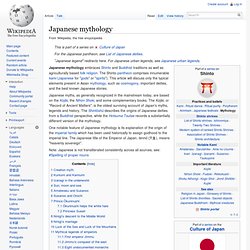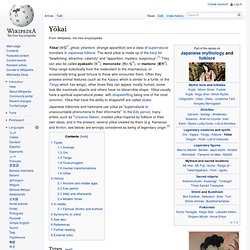

Kotodama. Kotodama or kototama (言霊? , lit. "word spirit/soul") refers to the Japanese belief that mystical powers dwell in words and names. English translations include "soul of language", "spirit of language", "power of language", "power word", "magic word", and "sacred sound". The notion of kotodama presupposes that sounds can magically affect objects, and that ritual word usages can influence our environment, body, mind, and soul.
The etymology of kotodama is uncertain, but one explanation correlating words and events links two Japanese words pronounced koto: this 言 "word; words; speech" and 事 "situation; circumstances; state of affairs; occurrence; event; incident". Kotodama is a central concept in Japanese mythology, Shinto, and Kokugaku. Chinese folk religion. Altar to the Five Officials worshipped inside the Temple of the Five Lords in Haikou, Hainan. The Chinese folk religion has a variety of sources, localised worship forms, ritual and philosophical traditions. Among the ritual traditions, notable examples includes Wuism and Nuoism.
Chinese folk religion is sometimes categorized inadequately as "Taoism", since over the centuries institutional Taoism has been assimilating or administering local religions. Zhengyi Taoism is especially intertwined with local cults, with Zhengyi daoshi often performing rituals for local temples and communities. Ritsuryō. Ritsuryō defines both a criminal code (律, Ritsu?) And an administrative code (令, Ryō?). During the late Asuka period (late 6th century – 710) and Nara period (710 – 794), the imperial court, trying to replicate China's rigorous political system from the Tang Dynasty, created and enforced some collections of Ritsuryō. Over the course of centuries, the ritsuryō state produced more and more information which was carefully archived; however, with the passage of time in the Heian period, ritsuryō institutions evolved into a political and cultural system without feedback.[1] Japanese mythology.
Japanese myths, as generally recognized in the mainstream today, are based on the Kojiki, the Nihon Shoki, and some complementary books.

The Kojiki, or "Record of Ancient Matters", is the oldest surviving account of Japan's myths, legends and history. The Shintōshū describes the origins of Japanese deities from a Buddhist perspective, while the Hotsuma Tsutae records a substantially different version of the mythology. One notable feature of Japanese mythology is its explanation of the origin of the imperial family which has been used historically to assign godhood to the imperial line. Yin and yang. In Chinese philosophy, the concept of yin-yang (simplified Chinese: 阴阳; traditional Chinese: 陰陽; pinyin: yīnyáng), which is often called "yin and yang",[1][2][3][4] is used to describe how opposite or contrary forces are interconnected and interdependent in the natural world; and, how they give rise to each other as they interrelate to one another.

Many natural dualities (such as light and dark, high and low, hot and cold, fire and water, life and death, male and female, sun and moon, and so on) are thought of as physical manifestations of the yin-yang concept. The concept lies at the origins of many branches of classical Chinese science and philosophy, as well as being a primary guideline of traditional Chinese medicine,[5] and a central principle of different forms of Chinese martial arts and exercise, such as baguazhang, taijiquan (t'ai chi), qigong (Chi Kung), and I Ching. Nature[edit] Toponymy[edit] Classically, when used in place names, yang refers to the "sunny side. " I Ching[edit] Ryukyuan religion. The Ryukyuan religion is the indigenous belief system of the Ryukyu Islands. Confucianism. Yōkai. Ukiyo-e print of yōkai, by Aotoshi Matsui Japanese folklorists and historians use yōkai as "supernatural or unaccountable phenomena to their informants".

In the Edo period, many artists, such as Toriyama Sekien, created yōkai inspired by folklore or their own ideas, and in the present, several yōkai created by them (e.g. Kameosa and Amikiri, see below) are wrongly considered as being of legendary origin.[2] Types[edit] There are a wide variety of yōkai in Japanese folklore. Animals[edit] Many indigenous Japanese animals are thought to have magical qualities. Oni[edit] Tengu[edit] A goblin from Japanese mythology that has several supernatural powers and skills in martial arts, the tengu were originally extremely dangerous demons and enemies of Buddhism.
Tsukumogami[edit] Tsukumogami are an entire class of yōkai and obake, comprising ordinary household items that have come to life on the one-hundredth anniversary of their birthday. List of legendary creatures from Japan. The following is a list of demons, ghosts, yōkai, obake, yūrei and other legendary creatures, which are notable in Japanese folklore and mythology. A[edit] B[edit] C[edit] D[edit] E[edit] F[edit] Fūjin - The wind god.Fūri - A monkey-like yokai.Funayūrei - Ghosts of people who died at sea.Furaribi - A creature that flies aimlessly engulfed in flames.Furutsubaki-no-reiFuru-utsubo - Animated jar.Futakuchi-onna - The two-mouthed woman.